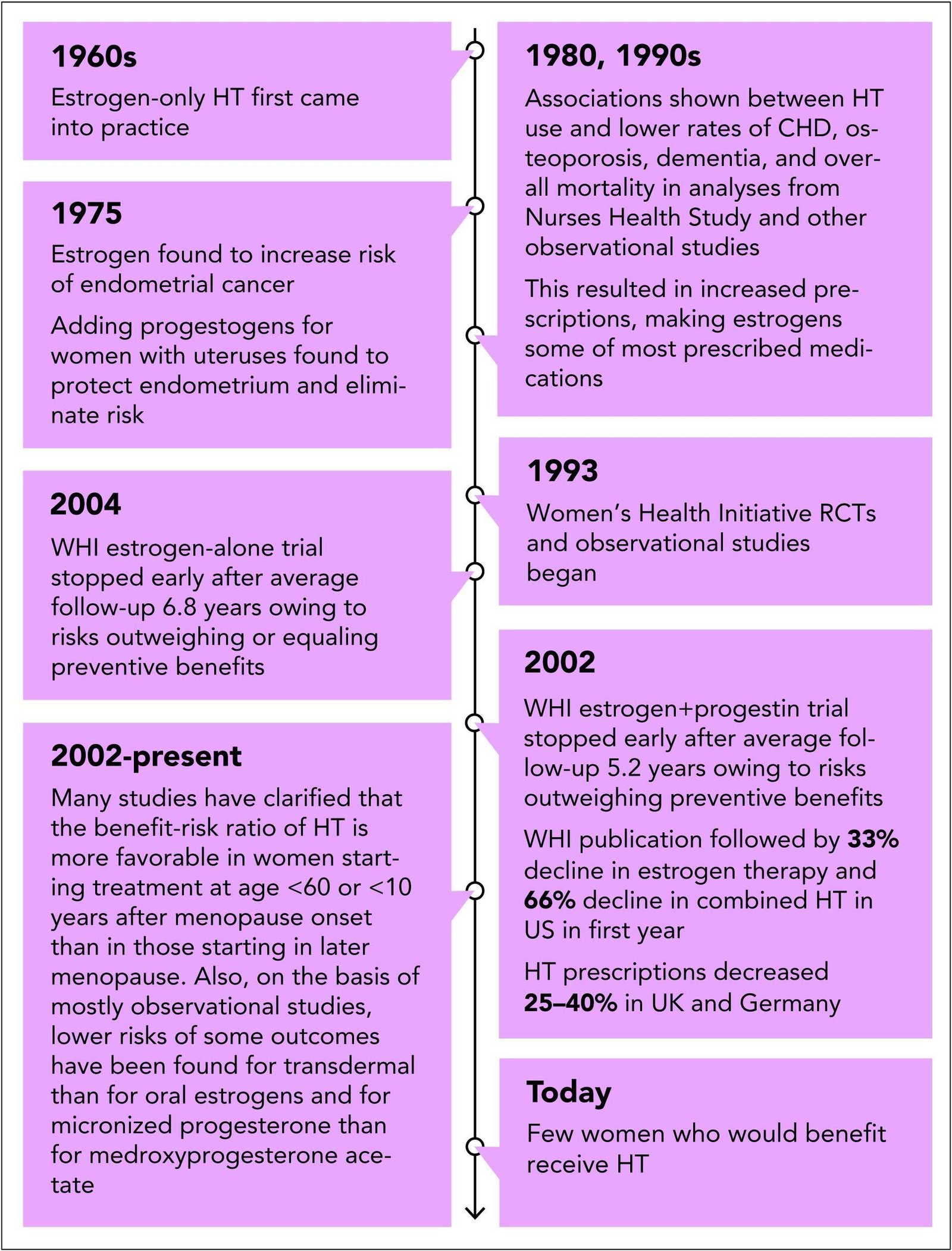How Mares Transformed Medicine: The History of Hormone Replacement Therapy (HRT)
Reading time 7 min

Reading time 7 min

Hormone Replacement Therapy (HRT) has a rich, multifaceted, and sometimes controversial history. It’s a narrative shaped by scientific advancements, societal changes, and women’s increasing role in healthcare decision-making. To understand the current landscape of HRT—and the debates surrounding it—we need to explore the history of hormone replacement therapy and how it has developed over time.
What is the history of hormone replacement therapy?
HRT began with crude ovarian extracts in the 1890s and evolved into modern hormone science with the development of synthetic estrogen, notably Premarin, derived from mares. Each decade added medical insights—and controversy.
The use of ovarian tissue as medicine predates modern HRT. In the late 1800s, doctors in Germany experimented with injecting dried and powdered ovarian tissue from cows into women experiencing menopausal symptoms. These early treatments demonstrated modest success in alleviating symptoms like sexual dysfunction.
By the 1890s, pharmaceutical companies like Merck began producing products such as Ovariin, which were among the first commercially marketed treatments using ovarian extracts. Ovariin was administered as pills containing powdered ovarian tissue, marketed as a remedy for menopause. Though primitive and imprecise, these early efforts laid the groundwork for the development of modern hormone-based treatments.
“The term ‘hormone’ was coined in 1905 by Ernest Henry Starling, a professor of physiology at University College London, UK.”
In the early 20th century, scientists began investigating the role of hormones in human health. The term “hormone” was coined in 1905 by Ernest Henry Starling, a professor of physiology at University College London, UK. The term was derived from the Greek word “hormão,” meaning “to set in motion, to arouse or excite .”
Researchers discovered the profound impact hormones have on numerous bodily functions. For women, this research provided insights into the roles of estrogen and progesterone in regulating menstrual cycles, reproduction, and overall health.

A pivotal breakthrough occurred in 1929 when estrone, a form of estrogen, was isolated. The researcher, A. Butenandt, was later awarded the Nobel Prize in 1939 for his work on sex hormones, including the isolation of estrone. By the 1940s, pharmaceutical companies began producing synthetic estrogen.
Premarin, made by isolating estrogen sourced from the urine of pregnant mares, was approved for alleviating menopausal symptoms in 1942. This marked the official start of hormone therapy as a medical treatment1, 2.
During the 1960s, HRT gained widespread popularity, partly fueled by Dr. Robert Wilson’s book Feminine Forever, published by M. Evans & Company. The book characterized menopause as a “deficiency disease” that could be “treated” with estrogen therapy, promoting the idea that it could preserve youthfulness and vitality.
By 1975, estrogen was the fifth most prescribed drug in the United States. While the narrative resonated with many women, it also contributed to the perception of menopause as a condition needing intervention rather than a natural stage of life3.
By the 1970s, concerns arose about unopposed estrogen therapy (estrogen without progesterone) and its association with an increased risk of endometrial cancer.
This led to the introduction of combined HRT in the 1980s, which included progestins, a form of progesterone, to mitigate this risk for women with intact uteruses. While this development improved safety, it also marked the beginning of deeper scrutiny of HRT’s long-term effects4.
In the 1990s, the Women’s Health Initiative (WHI) study aimed to address lingering questions about the benefits and risks of HRT. The initial results, released in 2002, highlighted increased risks of breast cancer, heart disease, and stroke in some women using certain types of HRT. These findings led to a dramatic shift in public perception and medical practice, with many women discontinuing HRT and doctors becoming more cautious in prescribing it.
Subsequent analyses of the WHI study revealed that the risks were more nuanced than initially reported. Factors such as the woman’s age, the timing of therapy initiation, and the type of HRT used significantly influenced outcomes. However, the initial alarm left a lasting impact, making many hesitant to consider HRT despite its potential benefits5, 6.
Today, HRT is recognized as an effective treatment for managing menopausal symptoms such as hot flashes, night sweats, and vaginal dryness. It can also help prevent osteoporosis and improve the quality of life for many women. However, it is not universally suitable. The decision to use HRT requires careful consideration of individual health factors, including age, medical history, and personal preferences7, 8.
“Today, HRT is recognized as an effective treatment for managing menopausal symptoms such as hot flashes, night sweats, and vaginal dryness.”
Advances in medical research continue to refine HRT options. Bioidentical hormones, designed to closely replicate natural hormones, are gaining attention for their potential to reduce risks. Personalized medicine, which tailors treatment to an individual’s unique profile, offers promising possibilities for the future of menopausal care.
Hormone Replacement Therapy is a subject of intense debate, and for good reason. I see HRT as both a remarkable advancement and a cautionary tale. For me, the key takeaway is this: menopause isn’t something that needs “fixing,” but for those struggling with severe symptoms, HRT can be a valuable tool when used thoughtfully and with the guidance of a knowledgeable healthcare provider.
I also believe that the narrative around HRT needs to shift. Instead of focusing on fear or false promises, we should emphasize balanced information. Women deserve the full picture—the benefits, the risks, and everything in between—so they can make decisions that truly work for them. After all, navigating menopause is not just about treatment options; it’s about reclaiming agency over our health and well-being.
Dr. Jūra Lašas
1.
Tata, J. One hundred years of hormones. (2005) https://doi.org/10.1038/sj.embor.7400444
2.
Kohn, G. et al. The History of Estrogen Therapy. (2019) https://doi.org/10.1016/j.sxmr.2019.03.006
3.
Bell, S. Sociological Perspectives on the Medicalization of Menopause. (1990) https://doi.org/10.1111/j.1749-6632.1990.tb30325.x
4.
Cagnacci, A. et al. The Controversial History of Hormone Replacement Therapy. (2019) https://doi.org/10.3390/medicina55090602
5.
Neves-e-Castro, M. et al. Results from WHI and HERS II – Implications for women and the prescriber of HRT. (2002) https://doi.org/10.1016/S0378-5122(02)00214-1
6.
Manson, J. et al. Menopausal Hormone Therapy and Health Outcomes During the Intervention and Extended Poststopping Phases of the Women’s Health Initiative Randomized Trials. (2013) https://doi.org/10.1001/jama.2013.278040
7.
Newson, L. Best practice for HRT: unpicking the evidence. (2016) https://doi.org/10.3399/bjgp16X687097
8.
Santoro, N. et al. The Menopause Transition: Signs, Symptoms, and Management Options. (2021) https://doi.org/10.1210/clinem/dgaa764